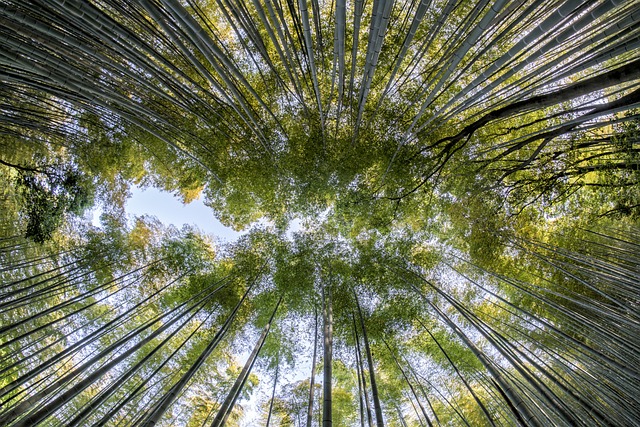Lucky bamboo and Regular bamboo may look similar at first glance, they are two very different plants. Lucky bamboo is actually a type of Dracaena plant that grows well in water, while regular bamboo belongs to the grass family and requires soil to grow.
Lucky Bamboo

Lucky bamboo is a popular indoor plant traditionally associated with good fortune, prosperity, and positive energy. It’s not actually bamboo but a type of tropical water lily called Dracaena sanderiana. Lucky bamboo is native to Southeast Asia and thrives in warm and humid conditions.
One of the things that make lucky bamboo stand out from other plants is how easy it is to care for. Unlike regular bamboo, which can grow quite tall outdoors, lucky bamboo stays small and compact when grown indoors in containers filled with water or pebbles.
Another fascinating aspect about this plant is its significance in Feng Shui practices. In Chinese culture, the number of stalks on a lucky bamboo plant has different meanings – two stems signify love, three mean happiness, five represent wealth or health while eight are believed to bring abundance.
Lucky Bamboo comes in many forms such as braided or twisted styles making them perfect additions to your home decor or office desk. They also come in various sizes ranging from tiny ones you can place on top of desks to larger ones that serve as room dividers.
Lucky bamboos are beautiful plants that require minimal effort when it comes to caring for them while adding aesthetic value into any space they occupy!
Regular Bamboo
(Photo by Fyre Willow on Unsplash )

Regular bamboo, also known as timber bamboo or Moso bamboo, is a type of plant that belongs to the grass family. Unlike lucky bamboo, regular bamboo can grow up to 100 feet tall and has a much thicker stem. It’s native to Asia but can be found in various parts of the world.
This versatile plant has many uses such as building materials for houses and furniture, paper production, clothing fibers, food (bamboo shoots), and medicine. Its unique physical properties make it ideal for construction purposes due to its strength and durability.
Moreover, regular bamboo is an eco-friendly option compared to other traditional building materials such as wood or concrete because it grows rapidly without requiring replanting. In addition, it absorbs more carbon dioxide from the atmosphere than most trees do making them perfect for reducing greenhouse gas emissions.
Bamboo forests provide habitat for endangered species such as pandas while generating significant income through tourism activities like hiking trails or nature walks. Regular Bamboo continues to play a vital role in promoting sustainability by providing renewable resources that meet human needs without harming our environment.
Lucky Vs. Regular Bamboo – Key differences
Lucky bamboo and regular bamboo may look similar, but they have some key differences. Firstly, lucky bamboo is not actually a true bamboo plant. It belongs to the Dracaena family and is often called “lucky” due to its popularity in Feng Shui practices.
In terms of appearance, lucky bamboo tends to be smaller and more compact than regular bamboo. While regular bamboo can grow up to several feet tall with thick stalks, lucky bamboo usually only grows up to two or three feet tall with thin shoots.
Another difference lies in their care requirements. Lucky bamboo thrives in water or moist soil, while regular bamboo requires well-draining soil and plenty of sunlight.
When it comes to symbolism and cultural significance, there are also notable differences between the two plants. In Chinese culture, for example, both types of plants are considered symbols of good luck and prosperity – however lucky Bamboo has specific meanings associated with particular arrangements!
While both plants share similarities such as their resilience and beauty – they each bring different benefits depending on your needs!
How to tell the difference between real bamboo and lucky bamboo?
It can be confusing to differentiate between real bamboo and lucky bamboo, especially for those who are new to the world of plants. Lucky bamboo is not actually a type of bamboo but rather a species called Dracaena sanderiana, which grows naturally in Cameroon and Central Africa.
One way to tell the difference is by examining the leaves. The leaves on real bamboo are much larger than those on lucky bamboo. Additionally, real bamboo has a hollow stem while lucky bamboo has a solid stem.
Another key difference is in their growth patterns. Real bamboos grow tall and upright while lucky bamboos stay relatively short and are often grown as houseplants.
If you still aren’t sure whether your plant is real or lucky, take note of its care instructions. Real bamboos prefer bright sunlight while lucky bamboos thrive in indirect light. Also, make sure that you’re using the appropriate plant food for your specific plant type.
By paying attention to these details, you’ll be able to confidently distinguish between these two distinct types of plants!
Uses of lucky Bamboo
Lucky Bamboo has become a popular decorative plant due to its easy care and flexible growth. It’s not only pretty but also versatile, making it an excellent choice for various uses.
One of the most common uses of Lucky Bamboo is as a Feng Shui element. In Feng Shui culture, arranging the plant in specific patterns or numbers can bring good luck and positive energy into your home or office.
Another use for this plant is as a gift item for special occasions such as weddings, housewarming parties, birthdays, and even corporate events. Its elegant appearance makes it a perfect present that symbolizes strength, resilience, and prosperity.
Moreover, Lucky Bamboo is believed to purify the air by removing toxins such as formaldehyde and benzene. This attribute makes it an ideal indoor plant that keeps your living space fresh while adding natural beauty to your surroundings.
You can also incorporate Lucky bamboo into DIY projects like terrariums or floral arrangements. Its slender stems give an intricate look when combined with other plants like succulents or ferns.
There are numerous ways you can use Lucky Bamboo aside from being just another ornamental piece in your room.
Uses of regular Bamboo
Regular bamboo is a versatile material that has been used for centuries in many cultures around the world. It’s known for its strength, durability, and flexibility. Here are some of the common uses of regular bamboo:
Construction: Bamboo can be used as a building material because it’s strong and lightweight. In fact, it’s often used to build houses and other structures in areas where wood is scarce.
Furniture: Bamboo furniture is becoming increasingly popular because it’s eco-friendly, durable, and stylish. From chairs to tables to bed frames, bamboo furniture adds a unique touch to any room.
Kitchenware: Bamboo kitchenware such as cutting boards and utensils have become popular due to their natural antibacterial properties. They’re also lightweight and easy to clean.
Gardening: Regular bamboo can be used in gardening for trellises or stakes since they are sturdy enough support plants like tomatoes or cucumbers.
Decorative items: Bamboo can also be turned into decorative pieces such as lamps, photo frames or even musical instruments like flutes.
These are just some examples of how versatile regular bamboo can be when utilized properly by people who know how useful this plant could get.
Featured Image By – Thanapat Pirmphol from Pixabay









